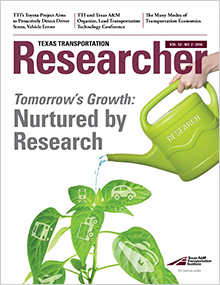
Agency Director
TRANSPORTATION TODAY IS IN TRANSITION. Congestion is clogging our roadways, particularly in urban areas, wasting fuel, polluting air, and negatively impacting the quality of life for everyday commuters. Expanding economies are demanding more responsiveness from our transportation system to optimize shipping and squeeze every ounce of efficiency out of the bottom line. Yet many of our roadways, bridges and other structures are in dire need of repair.
Do we fix what we have — at the cost of billions of dollars — or focus on paving the way for the connected and automated vehicle revolution already under way? Well, we have to do both. The world economy depends on a healthy, mobile transportation network to grow, so we must prioritize not only how we maintain the current system, but also how we integrate new technologies like self-driving cars into existing infrastructure. The challenge to accomplish both these economic necessities simultaneously is becoming more acute with time. Yet, agencies are finding their resources more stretched than ever to meet that challenge.
That’s where transportation research comes in. It’s part learning from the past, part looking into the future, and bridging the two as efficiently, safely and cost-effectively as possible. This issue of the Texas Transportation Researcher looks at how Texas A&M Transportation Institute (TTI) researchers continue to solve problems plaguing our existing system while also planning how best to transition from the old to the new.

For example, TTI’s Infrastructure Investment Analysis Program looks at every aspect of transportation — ports, transit, highways and pipelines, to name a few — to determine how to best to use the resources we have to build the system we need. TTI’s Center for Transportation Safety is studying how vehicle error and driver stress can be minimized to improve safety and, thereby, reduce the societal costs associated with them. The Institute’s Transportation Policy Research Center (PRC) has studied what factors are most important in bringing businesses to Texas, and decision makers can use its findings to make our state more attractive to entrepreneurs. In fact, researchers working on PRC projects regularly brief the Texas Legislature on transportation issues to help members understand the interdependence of transportation and economics and how they’re evolving together.
Part of that change involves how we move freight from the manufacturer to the marketplace. On behalf of the Texas Department of Transportation, TTI’s Multimodal Freight Program personnel have examined more than 50 advanced freight-movement strategies and technologies used around the world to see which ones can serve the future interests of Texas. And for the past seven years, TTI’s Center for International Intelligent Transportation Research has identified trends for freight movement across the U.S.-Mexico border to help both countries and Canada optimize the process and, ultimately, benefit consumers. You’ll read about the center’s latest conclusions in these pages.
How we get where we’re going and move goods to store shelves — through ports and over roads, by trains, planes and semi-trucks — is changing. We can’t build our way out of our problems of congestion, pollution and rising shipping costs; we just don’t have the money. We can’t simply snap our fingers and wake up in a future of automated vehicles talking seamlessly to roadside infrastructure. But by researching the big questions and finding the right answers, TTI can help mitigate the growing pains of our maturing transportation network while preserving, even enhancing, our nation’s economic vitality.
Tomorrow is coming. We all want it to be prosperous. Choosing the right road to get there is what research is all about.
